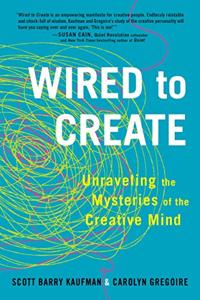
Want to learn the ideas in Wired to Create better than ever? Read the world’s #1 book summary of Wired to Create by Scott Barry Kaufman, Carolyn Gregoire here.
Read a brief 1-Page Summary or watch video summaries curated by our expert team. Note: this book guide is not affiliated with or endorsed by the publisher or author, and we always encourage you to purchase and read the full book.
Video Summaries of Wired to Create
We’ve scoured the Internet for the very best videos on Wired to Create, from high-quality videos summaries to interviews or commentary by Scott Barry Kaufman, Carolyn Gregoire.
1-Page Summary of Wired to Create
Overview
Creativity is often thought of as a singular attribute – you either have it or you don’t. However, that’s not entirely true. There are many traits and skills that make up creativity, some innate and others acquired through training. By understanding these skills and practicing them, anyone can become more creative.
The traits and habits of creative people are discussed in this chapter. It turns out that Picasso was not very organized, Jung dealt with emotional issues, and trauma can be helpful for growth.
Big Idea #1: The “messy minds” of creative people embrace contradictions.
Boldness is fascinating. We’re drawn to people who break the rules, like Kurt Cobain or Steve Jobs. However, what exactly makes these mavericks so magnetic?
Creative minds are difficult to define. A study in the 1960s found that there was no single source for a creative mind. In addition, some of the most creative people were paradoxical in their thinking and behavior. For example, they tended to have high IQ scores but also showed signs of mental illness or poor health overall.
Creative people have messy minds. They think in paradoxes and contradictions, which is reflected in their work habits. Pablo Picasso’s painting Guernica was created with no clear plan—he improvised while working on it and revised his ideas as he went along. He wasted a lot of effort but eventually came up with an amazing piece of art that everyone loves.
Instead of making a schedule and sticking to it, creative people seem to follow the demands imposed on them by their work. Psychologist Mihaly Csikszentmihalyi notes that creatives don’t stick to a rigid structure, but rather obey the demands of their field.
Big Idea #2: Creative people are highly driven to master the things about which they’re passionate.
The popular perception of artists is that they’re creative geniuses who work tirelessly. But this stereotype isn’t true for all artists. Some are more passionate about their art than others, but it doesn’t necessarily make them better at creating great works of art.
Where Does Passion Come From?
Most people go through a defining moment in their lives that makes them want to be creative. They engage with an activity that affects them deeply, and it becomes part of who they are.
For instance, a young Jacqueline du Pré was so passionate about music that she knew at age four that she wanted to be a cellist.
Creative people have a need to master their craft. They’re driven by the “rage to master” and they work towards achieving their goals with great intensity. Creative people are able to focus intently on what they love because it satisfies a neurological need in them, as well as helping them achieve success. In one long-term study, E Paul Torrance found that personal passion often develops in childhood. By the time they entered elementary school, many of the children in his study had already developed a particular passion and this interest usually persisted (or increased) as they grew older. He also found that childhood passions were more likely to result in creative success than those who weren’t passionate about something when young but still achieved academic success later on during high school or college years.
Big Idea #3: By nature, creative people are sensitive and perceptive.
People often think that artists are unafraid of performing in front of others and have a lot of self-confidence.
Although artists are known for being outgoing and bold, they often have sensitive personalities. Psychologist Jennifer O. Grimes interviewed musicians at heavy metal music festivals and found that all of them were highly sensitive to their surroundings. They could hear small sounds like a bell ringing in many different ways, which is partly due to biology because some children are born with hyperactive nervous systems and therefore have more sensitivity than others do.





